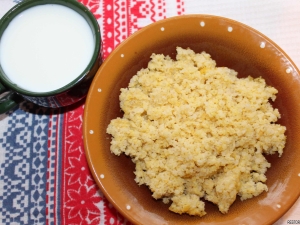Why does millet porridge taste bitter and what to do to get rid of bitterness?

Millet porridge is an incredibly healthy dish for children and adults. It is rich in B vitamins and many macronutrients.Despite the enormous benefits, such porridge appears less and less every year in the diet of a modern person. And there is an explanation. The fact is that the finished dish may have bitterness, which spoils its taste. Let's try to understand why porridge gets bitter, and whether there are ways to get rid of it.
Causes of bitterness
To deal with this issue, let's start from the beginning. Millet groats are made from millet seeds. When processing them, the husks covering the shell of the grass are removed. After that, millet is packaged and supplied to retail outlets for sale. Most often, from such cereal cook porridge on the water or milk.
Many housewives have noticed that with the observance of the cooking technology of millet, sometimes the dish has an ideal taste, and sometimes bitter. The reason is simple, millet seeds have vegetable fats in their composition. And over time, when interacting with oxygen, any fat begins to oxidize. The result of this process is Rancid vegetable oils, which spoil the dish, provoking an unpleasant taste.
Select the main causes of bitterness:
- use of old grain;
- use of fresh millet, which was stored under the wrong conditions (for example, not in a darkened and cool place, but when exposed to direct sunlight).
To reduce the risks of acquiring low-quality wheat, it is necessary to familiarize yourself with the rules for its selection.
How to choose millet?
First of all, when buying millet groats, you should pay attention to its appearance. Good croup has a monophonic, bright yellow color without white bloom, stains and other inclusions. The faded color of the grain and the presence of dirt indicate that you have a poor quality product. When choosing products, be sure to check the expiration date. If everything is in order, you can safely take millet.
When buying millet grain by weight, you should purchase goods from time-tested sellers. There are unscrupulous "traders" who repackage expired grain, stick a label with a new date and once again lay out the products in the shop window. Even with the above rules, everyone has the risk of purchasing rancid millet.
If this happens, you need to know what to do, so that the porridge turned out without bitterness.
What to do so that millet does not taste bitter?
If porridge is cooked from rancid seed, it will not be possible to get rid of this problem. You can only try to “soften” the dish by adding steamed dried fruits, berries, jam or vanilla. If the cereal is only to be boiled, then you can secure yourself in advance. The bitterness can be removed in the only way: by washing away the oxidized oils from the shell of millet.
To do this, sort out the cereal, rinse it from dust and pour hot water over it. Use cold liquid is useless. After 2-3 minutes, the croup is stirred and the water is drained. Further, it is necessary to pour hot water over the millet and repeat the manipulation. Such actions should be repeated until the liquid is completely transparent. Turbidity will indicate incomplete fat removal.
There is a slightly different way to get rid of bitterness. It will require less effort. To remove the unpleasant taste, millet must be poured with cold water and put on the stove at high heat. At the time of boiling, you need to drain the liquid with dissolved rancid fats, rinse the grits from the residual oils, then refill with clean water and cook until ready.
Is it possible to eat a dish with a rancid taste?
If the shelf life of the cereal has not gone out, but the dish prepared from it has a slight bitter taste, it is allowed to be eaten. However, if the bitterness remains after thoroughly washing the cereal or boiling it, it is better to discard the finished porridge along with the remaining millet. It is not necessary to add jams or jam in a similar dish to reduce bitterness, you must immediately abandon it. Otherwise, such a product can cause health problems: from diarrhea to nausea and vomiting.
Particularly dangerous porridge from rancid cereals to young children.
To reduce the risks of oxidation of vegetable fats in millet, it is not necessary to purchase it for the future. Prolonged storage of millet reduces not only its taste, but also a beneficial effect on the body. It is also important to take care of the correct preservation of the purchased product.
For storage of millet grains is best to use a refrigerator. It is important that the grain is in a dark and cool place in an airtight container. Storage in torn packaging or plastic bags is undesirable. It is best to pour the cereal into a glass jar and close it with a tight lid. Due to the observance of recommendations for the selection and storage of wheat, as well as its proper preparation, you can cook tasty and healthy porridge for the whole family.
You will learn more about how to get rid of the bitterness in the millet porridge, from the following video.

























